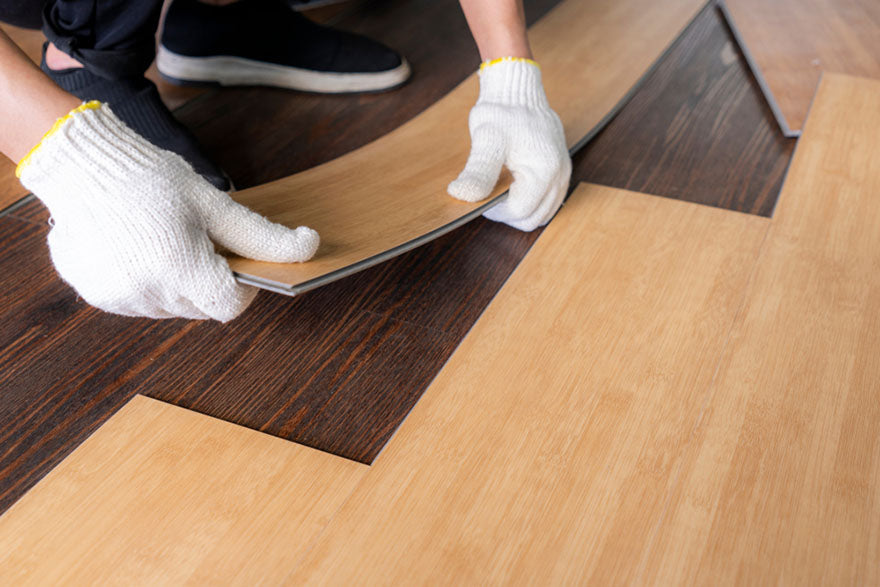
Can You Put LVP Over Tile?
Source: appleyayee/Shutterstock.com
Your home’s flooring is more than a surface for everything to stand on; it’s also an opportunity to express your character and style. Many homeowners love hardwood floors but can’t bring themselves to splurge for them. Luxury vinyl plank flooring, or LVP, is a beautiful option that mimics the look of hardwood. If your floors currently have ceramic tile, you might wonder if you can install LVP on top of it. When the conditions are right, many subfloors, including tile, can support LVP.
Look Into Vinyl Plank FlooringPROS AND CONS OF INSTALLING LVP OVER TILE
If your tiles don’t match your gray cabinets, LVP might give you color options that work well with the rest of the room. This low-maintenance material can go in quickly and easily without you having to remove the tile, and you can save a lot of money in the process. If you use floating vinyl flooring, you can easily remove it later if you wish to do something different.
Your baseboards will get shorter because the floor is higher than it used to be, but it is a matter of millimeters, not inches. Transition strips between tile and carpet might be necessary, and your existing tiles aren’t likely to be usable in the future.
Shop Gray CabinetsPREPARING TILE FOR LVP INSTALLATION
After cleaning the floor, prepare the surface with a self-leveling compound and smooth it out with a putty knife. Take precise measurements to verify that the LVP flooring height won’t prevent you from conveniently using doors, cabinets, fixtures, and appliances. Ensure you won’t disrupt airflow from vents or registers.
STEP-BY-STEP GUIDE TO INSTALLING LVP OVER TILE
First, you need to choose the variety of LVP you want to install. You have two primary choices. The first is click-lock or floating LVP, which interlocks like a puzzle without adhesive. The second is glue-down planks. They are cheaper but more permanent, and you can install them using either a brushed-on adhesive or a peel-and-stick method.

Source: Kingsman Asset/Shutterstock.com
Whichever type of LVP you choose, start with room measurements and buy enough flooring—about 20% more than you think you’ll need. Remove the baseboards before applying compound to even out your flooring.
To install floating LVP, start with two adjoining pieces near the center of the room. Line them up. Use a tapping block to gently fit two pieces together. This prevents damage to click-lock joints. Once floating planks are installed, the room is ready to use.
Glue-down planks involve more tools and labor. Apply adhesive if necessary, or use peel-and-stick panels starting at the center of the room. Adhesive planks need to be put in place within two hours of the glue, and they need two to three days to set fully before foot traffic and furniture enter the room.
With both floating and glue-down planks, work outward from the center of the room, trimming pieces as necessary when you reach the walls. Finish by reinstalling your baseboards.
POTENTIAL ISSUES AND HOW TO AVOID THEM
Fill in any grout lines thoroughly so that the planks lie without gaps. Thorough cleaning is necessary to prevent debris and dirt from getting trapped under the new planks; otherwise, your LVP might buckle or shift over time. Waterproof underlayment between the planks and tile substrate is always a great idea.
CARE AND MAINTENANCE OF LVP OVER TILE

Source: appleyayee/Shutterstock.com
Caring for your LVP over tile is simple. If you have a designated housekeeping day, you can handle these the same afternoon you clean your polar white cabinets. Regular vacuuming is the core task here, but you need to spot-clean any spills as soon as they happen. Removing dirt and debris quickly helps prevent damage, and you can use mild soap and water to avoid discolorations and stains. Don’t use abrasives or harsh chemicals, as they can damage the materials.
CONCLUSION
You can put LVP flooring over tile, wood, and concrete. Whether you want a new look or something that aligns well with your Stonecreek cabinetry, you can treat your home to attractive flooring that brings versatility and durability to any room you want to upgrade. LVP is more budget-friendly than genuine hardwood, and it’s easy to install when you take the proper steps.



